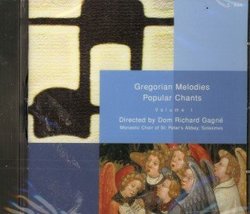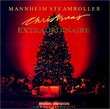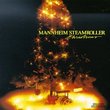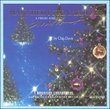| All Artists: Gregorian Chant Title: Gregorian Melodies Popular Chant 1 Members Wishing: 0 Total Copies: 0 Label: Solesmes Release Date: 8/12/2003 Genres: Special Interest, Pop, Classical Styles: Vocal Pop, Opera & Classical Vocal, Historical Periods, Early Music Number of Discs: 1 SwapaCD Credits: 1 UPC: 709887084423 |
Search - Gregorian Chant :: Gregorian Melodies Popular Chant 1
 | Gregorian Chant Gregorian Melodies Popular Chant 1 Genres: Special Interest, Pop, Classical
Taken from the tenth to the seventeenth centuries, this compilation of familiar, most "requested" chants ranges from Tantum Ergo and Adoro to hymns from the service of compline. An ideal disc for those who are familiar wit... more » |
Larger Image |
CD DetailsSynopsis
Album Description Taken from the tenth to the seventeenth centuries, this compilation of familiar, most "requested" chants ranges from Tantum Ergo and Adoro to hymns from the service of compline. An ideal disc for those who are familiar with the chant liturgy, as well as for newcomers. Similarly Requested CDs
|
CD ReviewsNoble intent; muddy execution C. Scanlon | among us humans | 11/25/2008 (3 out of 5 stars) "I could not believe over a year ago a trusted and very knowledgeable friend who told me the Solesmes recordings after Dom Claire (and thus well after my departure from that cloister) were of lesser quality.
By this disk, I believe. The usual comprehensive and polyglot brochure incldued within this one cd case, here of twenty pages and three languages, explains the purpose in recording thus (forgive the lack of accentuation): "( . . .)D'ailleurs, ce disque repond aux demandes reiterees de fideles desirant reentendre les chants latins conserves dans un coin de leur memoire: l'Adoro te ou bien le Tantum ergo . . . Nous esperons egalement qu'il sera un stimulant pour les chorales de nos paroisses d'aujourd'hui a reprendre certaines de ces melodies dans leur programme dominical, car ces chants ne sont pas que des chants du passe: il font partie du patrimoine de la musique sacree et, a ce titre demeurent immortels. Ils sont (sic - ont?) aussi le merite non negligeable d'estre abordables par les non-specialistes (p.1)." The English column: "( . . .)In fact, this recording is an answer to the reiterated requests of those who wish to listen to the latin (sic) chants they used to hear long ago (Adoro te, Tantum ergo, etc.). Our added hope is that this new recording will inspire today's parish choirs to integrate anew some of these pieces in their Sunday programs, for they are quite easily learned by non-specialists. These are not relics of another age, however awesome, but part of the ongoing heritage of sacred music: they are quite simply immortal (p.1)." The English column then concludes with a reference to the Liber Cantualis as available from Paraclete Press which provides in the USA these Solesmes recordings. The French column continues with more reflection about the chant in general, and a recommendation of the Liber Cantualis directly from Solesmes, its publisher. And so the sound: When I was there in the mid-seventies recording, professional sound engineers carefully placed microphones by the schola or soloists for greatest clarity of sound, even within the heavily echoing and reverbing sanctuary. With the full choir, recording provided for the greatest breadth, depth and motion of processionals. Some recording was done in the less echoing Chapter Room or Library whree the wood would absorb the resonance and overtones. In the vaulted sanctuary, despite wooden choir stalls, the sound echoed on forever, and overtones would ring angelicly yet covering the sound far below. This recording in this present disk does not sound angelic, only very annoying, as if the one microphone was placed halfway down the nave, where all individual sounds and notes blend and mix into a wall of many notes echoing on. Despite the enthusiasm of the introductory remarks quoted above, it would be very difficult to follow cleary the chant from this muddied recording. It would be hard to learn the simple, one note melody line with all echoing and mixing together. It is as if we were to follow a simple one note line of melody from a violin which had been electronically squeezed through a reverd and a digital delay box. Perhaps this sounds quite relaxing to one who is not listening carefully, to one who need not learn the melody, but I found it quite disturbing, as my friend had warned so well. In any case I find it disturbing to hear chant separate from its liturgical setting, and out of liturgical order, with Kyrie following Credo, etc. and even following the chants of Compline. I found it very difficult to listen to this mud, as it would be to watch a sacred liturgy through a thick screen, and recommend vey much the earlier recordings from Solesmes, as well as Women in Chant: Gregorian Chants for the Festal Celebrations of the Virgin Martyrs and Our Lady of SorrowsWomen in Chant: Recordare: Remembering the Mysteries in the Life of Jesus, Son of Mary and especially now Women in Chant: The Announcement of Christmas. In fact on those three you may hear my dear old friend who warned me so well so long ago now." |

 Track Listings (29) - Disc #1
Track Listings (29) - Disc #1








